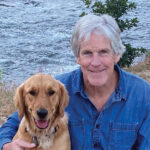From the Editor
Tim Kiesling
"We’re celebrating 20 years of S&H, and I find myself sorting through old stories, trying to make sense of things. What’s real? What matters? What did I miss?"
We’re celebrating 20 years of S&H, and I find myself sorting through old stories, trying to make sense of things. What’s real? What matters? What did I miss?
In the movies, a Japanese Zen master picks up his longbow and eventually becomes one with the arrow and one with the target until—sthwit—arrow and target become one. Bull’s-eye! But I grew up with a Japanese Zen priest in our basement, so I got to travel beyond the target—and climb the fence and experience the silence of a lost arrow. So much meditating and he missed! At 16, that was all the Zen I needed to know. (That was before we could actually see the ways the brain is reshaped by such quiet hard work.) But it wasn’t until I told my story of the missed arrow to the famed Tassajara bread maker and Zen priest Edward Brown that I finally realized that Zen really isn’t the disembodied practice I always thought. I learned a lot and hope you will, too.
Other thoughts have evolved as well. My first magazine article, in 1981, reported a study showing that the secret to keeping memories intact in old age is a heathy cardiovascular system. Another early article described how vitamin absorption from the foods we eat increases with exercise. (For the new fundamentals of supplements click here, but keep in mind that exercise is like a super-supplement because you metabolize so much more of all the vitamins you already eat.) Still another early story was about sugarcane workers who ate 5,000 calories per day of raw sugarcane and didn’t get diabetes. Those studies confirmed my own experience as an Olympic rower: Bodies in motion stay in motion—almost no matter what the fuel.
I still think those old stories are true. Stay in motion! And spring is the best time to get going! But I now know that motion can’t fix poor food choices forever. Inflammation from poor foods accelerates the internal chaos we call metabolic syndrome, heart disease, and dementia. Dr. Deanna Minich, who graces our cover, points out that long-term health comes from foods that cool inflammation. (50) And those same foods that cool our bodies can be grown in regenerative ways that cool the planet. So, the very best practices to prevent “inner climate change” are the very best practices to heal climate change. That’s a big idea. The time is now!
Here’s another big idea: Feel a tightness in your chest? A constricted throat? Shallow breathing? Antsy feelings? Insomnia? Dry mouth? Headaches? Rapid heartbeat? Sweating? These are common symptoms of what’s called anxiety disorder or a panic attack—and a common response is a pill like Prozac or Zoloft. The entire body is screaming and we accept pills to shift the brain. I get it, having experienced the terrifying symptoms. But do we really want silence like that? Like a missed arrow? Instead, therapist Sheryl Paul teaches us to pay attention and perhaps to even feel grateful for what the body is trying so hard to communicate.
Nobody goes looking for “the dark night of the soul.” But I suspect it’s hard to find a very interesting person without one. My own dark night began while swimming in a sea of what we now call fake news. The search for a faith to believe in brought me to the launch of this magazine. And that same search brought so many of you who read the magazine and who share your own stories, like the minister who wrote “To Zen and Back.” Here’s to another 20 years!


